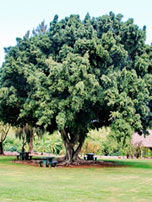Plaksha

Botanical Name : Ficus microcarpa Linn. f.
Family : Moraceae
Introduction :
This plant have aerial roots, very much useful in skin disease.
Names in different Indian languages :
Hindi : Kamarup
Kannada : Itti
Malayalam : Itti
Sanskrit : Plaksha
Tamil : Kallicci, icci
Telugu : plaksha
Synonyms :
Ficus retusa auct. non Linn
Varieties & adulterants – (CV – controversy, AD – adulterants) :
Ficus lacor – CV
Ficus amplissima – CV
Morphology :
Medium sized tree, with aerial roots.
Leaves – simple,alternate, lanceolate
Flower – hypanthodium
Fruit –globose, yellowish when ripe
Distribution & Habitat :
All over India
Chemical constituents :
methylricinolate, beta-sitosterol, lanosterol, caffeic acid,
Properties :
RASA-kashaya
GUNA-guru
VIRYA-sitha
VIPAKA-katu
Karma : vranasodhana, raktapittahara, yonisodhana, sophahara
Indication :
ulcers, diarrhea, diabetes, ulcer, dropsy, skin diseases, oedema and inflammations
Part used :
Root, bark, resin
Dosage :
Powder 2-4 g
Important Yogas or Formations :
Panchavalkaladi ghridha and taila, naalpamaradi kashya and taila
Therapeutic Uses :
1. Bark decoction useful in skin disease
2. Bark powder + sundi + haridra useful in oedema